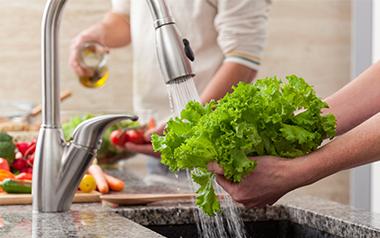Volumetric flow rate is defined as the volume of water that passes through a given surface per unit time. Or more simply, the speed at which water flows through a pipe. Water velocity, pipe diameter, and friction loss all influence volumetric flow rate. The flow rate helps you know which system, whether it's a carbon filter, UV system, or water softener, is right for your home appliances.

Why flow rate is important for water treatment
A home treatment system sized based on the appropriate flow rate should:
- Process the home's flow rate requirements based on the number and types of fixtures
- Avoid excessive pressure and/or flow loss
- Treat water effectively at peak and service flow rates
- Allow for adequate contact time with filter media
Excessive pressure and flow loss
Pressure and water flow are measured differently yet directly affect one another. For example, when you press your thumb to the end of a garden hose, the water comes out at high pressure but low flow. When you remove your thumb, the flow rate increases, but pressure decreases.
A system must be able to withstand a 15 psi pressure loss and still do its job well. When you're taking a shower, you want water flow and temperature to remain the same even if someone else flushes the toilet. That's why measuring both service and peak flow rates is important. Service flow rate refers to your normal water flow. Peak flow rate measures maximum water flow. If every shower, toilet, or appliance was in use at your home, then water would reach its peak rate of flow.
Plumbing size
The diameter of plumbing pipes limits the flow of water depending on their size. The larger the pipe's diameter, the greater the water flow. For instance, the flow rate of 3/4" pipe is approximately 13.5 (gallons per minute) gpm, while a 1" pipe flows at a higher rate of approximately 21 gpm.
Over-sized water filtration equipment means you have extra flow rate capacity, and that's not a bad thing. Having undersized equipment, however, can lead to unsatisfactory water pressure. Our water specialists received a call from a homeowner, whose large shower had multiple heads, wondering why the home's filtration equipment wasn't providing full flow. Our water experts calculated the home's service flow rate, which equaled 30 gallons per minute (gpm), but the home's water pump could only service 25 gpm. From calculating the flow rate, we knew the homeowner needed a larger pump to accommodate the home's 30 gpm flow rate.
Contact time
Contact time is the amount of time the water spends passing through filter media for the adsorption process to occur. Adsorption happens when particles stick to the surface of a solid adsorbent material, like granular activated carbon (GAC). Unlike absorption, molecules are not assimilated into the solid.
The filter media's effectiveness relates to a given flow rate per cubic foot. The faster the flow rate, the less contact time dirty water has with the filter media and the less effective the filter. Water must have adequate contact time with the media to remove impurities while it passes through. UV systems operate in a similar way. Disinfection is directly affected by the amount of contact time the UV light has with the water.
Often, water flows through the filter too fast because the system was not sized according to the proper flow rate. A flow restrictor may be needed to slow the flow and increase contact time.
How to measure flow rate

Flow rate is expressed in gallons per minute (gpm).
- To calculate service flow rate: add the flow rates for fixtures and appliances that may run longer than 10 minutes.
- To calculate peak flow rate: add the flow rates for the maximum numbers of fixtures and appliances that may run at the same time.
- Choose a water filter or treatment system that can manage both flow rates.
The bucket test
A bucket and a garden hose can also help you determine flow rate. Simply take a garden hose and a 5-gallon bucket and time how long it takes to fill the bucket with water. This will give you the water flow rate in gpm.
